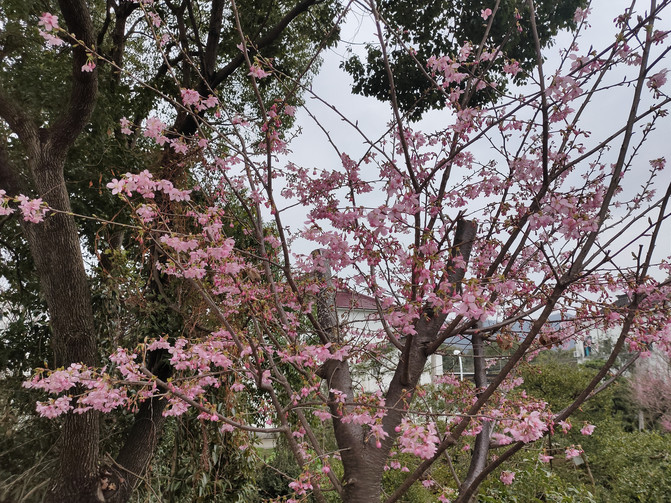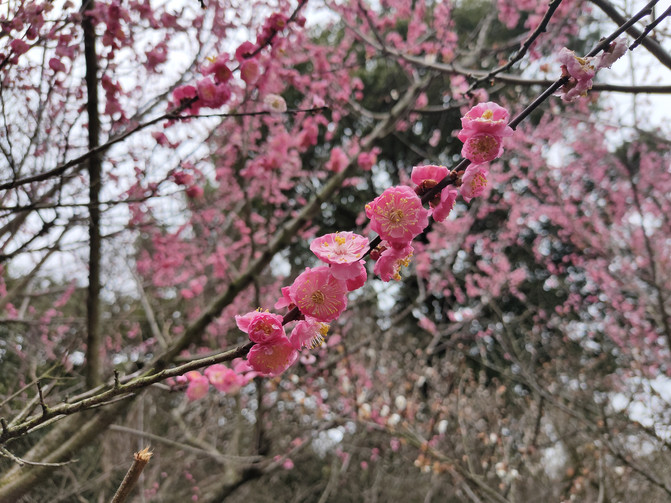Deng Wei Xiang Xuehai was favored by two generations of emperors
★ Flower viewing location: Xiangxuehai, Suzhou
Although there are many places to admire plum blossoms in East China, some of which are larger than Xiangxuehai, there is still only one named after Xiangxuehai. There is no other branch, which shows that it has its own place to admire plum blossoms.
Guangfu has a long history of growing plum blossoms, dating back to the late Qin and early Han Dynasties. For more than two thousand years, plum cultivation has not only remained maintained, but has also radiated to surrounding areas. Yao Ximeng, a man of the Ming Dynasty, once wrote in the preface to "Mixed Ode of Plum Blossom":"The prosperity of plum blossoms has to be pushed to Wuzhong, but the Guangfu Mountains must be the most important." It can be seen that Guangfu plum planting has existed in ancient times and is very large.
The plum blossoms in the Guangfu Mountains "span fifty to sixty miles", which shows that Guangfu had begun to plant a large number of plum blossoms at that time. It should be said that there are many literati in Suzhou, and literati generally love the "Three Friends of Cold Years" and the "Four Gentlemen of Plants", and plum blossoms are among them. Therefore, celebrities and scholars who live in seclusion in Guangfu have become a trend to plant plum blossoms. Xiangxuehai is one of the best among them. The annual Deng Wei Plum Blossom has attracted countless tourists, and "Deng Wei Plum Blossom" has also become the first choice for early spring travel for surrounding residents.
In his "Examination of Plum Blossom Places in China", Cheng Jie focused on sorting out the plum blossom scenic resources in various parts of our country since the Wei and Jin Dynasties, and made a detailed study on the rise and decline, reasons for their rise and fall, scenic characteristics, resource values, and historical status of more than 140 scenic spots since ancient times. To be able to stand out among many plum blossom attractions is definitely powerful.
When it comes to the plum trees in Xiangxuehai, the scale of planting is indeed quite large. There is a forest at the foot of the mountain, and plum trees are also planted on the hillside, stretching all the way to the top of the mountain. Because it rained just two days ago, today's plum blossoms seem to lack a little spirit. The main reason is that the rain hits the plum blossoms and countless red blossoms fall. On the other hand, if beautiful plum blossoms are connected to flowering, the trees will bloom pink. However, the beautiful plum trees here are not large enough and can only be used as supplements to the plum trees. The red plum blossoms are blooming well, but the white plum blossoms seem to have withered prematurely. Therefore, at a glance, the white plum blossoms are only dotted with stars, like scattered snow, and their eyes are full of light pink and bright red. It is really beautiful.
Emperor Kangxi and Emperor Qianlong of the Qing Dynasty made several rounds to the south. They visited Deng Wei six times to explore plum blossoms and wrote 19 poems. Now, there is still a poem sung by Emperor Qianlong on the slope of Xiangxue Sea. Of course, Emperor Qianlong left too many calligraphy treasures, but Emperor Kangxi did not leave calligraphy treasures so easily, which shows his love for Xiangxuehai.
Emperor Kangxi toured the south six times in his life and stayed here several times. Emperor Qianlong had even more people, attacking Deng Wei six times to explore plum blossoms. Even the emperor loved this place so much, and Xiangxuehai was naturally famous all over the world. Even in ancient times when information was not so developed, Deng Wei Meihua was famous.
In the 15th year of Qianlong, the Qing army marched westward and put down the Jinchuan Rebellion, and the political situation stabilized slightly. Qianlong had always liked to travel, and the minister around him, He Kun, the traitor who was particularly famous in history, immediately understood the emperor's meaning and praised in front of the emperor how beautiful the mountains and rivers of the Yangtze River were. Coupled with his grandfather, the Holy Ancestor Kangxi made six southern tours. Emperor Qianlong followed his grandfather, and there seemed to be nothing wrong with it. So the following spring, Qianlong took his entourage. It was estimated that Ji Xiaolan and He Kun were enemies among them. They traveled to Jiangsu via Hebei and Shandong. When I came to Suzhou, I heard that Xiangxuehai plum blossoms were in bloom, so I naturally couldn't help but go and watch them. How could Qianlong not visit a place where even Emperor Kangxi was inspired to write poems? So the group arrived at Deng Wei and couldn't help but be delighted to see the fragrant plum blossoms all over the mountains and fields. It was a regular meal for the emperor to leave behind calligraphy treasures. When he was in a good mood, he naturally did not hesitate to write poems. After the first trip, there were five more southern patrols, and each time they would specially choose the flower season to visit Dengwei to explore plum blossoms. After climbing Deng Wei six times, Emperor Qianlong wrote more than ten poems praising Guangfu Plum Blossom.
With the blessing of two generations of emperors, it would be difficult for Xiangxuehai not to be famous in the world! As a result, Xiangxuehai became the first resort to explore plum blossoms in early spring, and it truly deserved its name.


The fragrant snow sea on the mountain of Dengwei Mountain is full of spring.
The light rain and fragrant fragrance fall in the south of the Yangtze River, which washes away the old dust.
--Seven Wonders




















































Previous Article:Baima River Longchi, an indissoluble bond with Little Bailong (Part 2)
Next Article:Come to the poetic Jiangnan and listen to the melodious Wu songs
